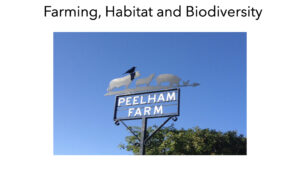Pasture Champions: Peelham Farm and Denise Walton
 Peelham Farm biodiversity case study. Image courtesy and copyright of Denise Walton
Peelham Farm biodiversity case study. Image courtesy and copyright of Denise Walton
Peelham is a 670ac family-run mixed commercial farm. The farm is predominantly cattle managed to certified Pasture-for-Life and Organic standards with an on-farm butchery and charcuterie facility. Grassland management has evolved to a rotational grazing system with Aberdeen Angus cattle, producing live-weights of c.500kgs in 19 months. Cattle groups of 30 are moved to 10ac paddocks every three days. Young stock are winter-housed on straw and fed silage. Other farm livestock (sheep and free-range pigs), are worked around the principle cattle enterprise.
 Certifications - Pasture Fed and Organic
Certifications - Pasture Fed and Organic
Biodiversity is the management lynch-pin of Peelham’s farming enterprise. Building habitat-infrastructure above ground has increased resilience and future-proofed the farm to weather pattern changes in particular. Grassland and soil management continue to improve resilience and productivity below ground.
The farm is located close to the Berwickshire Coast in the Southern Upland fringes of the south-eastern Scottish Borders. It is perched at 200-700 feet, on the water-shed between the lower reaches of Whiteadder Water and the Eye Water. It is topographically and geologically diverse; The south of the farm overlies Lower Devonian Andesites and has a history of grazing. The northern area of the farm is more lowland in character and overlies Upper Old Red Sandstone with a history of arable cultivation. The farm’s landscape is typically glacial with round topped knolls and knowes, with bedrock close to the surface. Its soils are predominantly acidic brown earths with gleyed depressions. It is Land capability class 3.1 with some 4.1
Peelham doesn’t farm its cattle.
It farms with them.
Coupled with close proximity to the sea this results in a diverse range of habitats. In addition to the typical agri-ecosystem habitats of predominantly improved grass pasture including significant areas of rough grazing and fragments of unimproved acidic grassland, it has aquatic, wetland (both acidic and base-rich) and woodland (mixed and broadleaved plantation and including native, secondary semi-natural woodland), and also a mosaic of heathland and acidic grassland. Two running water habitats rise and run through the farm. There is also a network of recently restored and planted hedgerows and woodlands.
Farm management including habitat creation and restoration has increased the farm’s biodiversity value. It has focussed principally on habitat infrastructure, included the planting of 4.0 - 6.0kms of hedgerow (75-80% inc), 12ha woodland (50% inc), and the creation of five ponds (a 7-fold increase in area); Improvements in habitat structural diversity are measured in Edge length density of 65m/ha and habitat nodal connections which have increased from 8 to 38.
Biodiversity surveys (flowering plants, mosses, butterflies, moths and birds), have revealed species of regional and national value including four UKBAP priority moth species, the nationally rare Pearl Bordered Fritillary; a good selection of key breeding farmland birds indicative of habitats in good health (Grey Partridge, Linnet, Tree Sparrow, Reed Bunting, Yellow Hammer, Skylark, Whitethroat, Barn Owl etc), and significantly the nationally rare Corn bunting. Surveys have been undertaken mostly by local volunteer groups (eg RSPB, Butterfly Conservation, Botanical Society of the British Isles).
An indepth whole-farm soil analysis (2020), revealed average Organic Matter content of 7.97% (5.4% - 15.5%); average Soil Organic Carbon 60.63 – 281.53 tonnes per hectare; Microbial Bio-mass 2340 – 4606 mg/kg. The southern part of the farm with the continuous history of grazing has the consistently higher results and scores. This will form the basis of ongoing monitoring of sequestered Carbon.
There is still a lot more to do. In particular grassland species mixes need to become more diverse and the older existing woodlands need areas of underplanting. Calving is being moved out-of-doors to reduce reliance on bought-in-straw. More rotational paddocks are to be fenced. Peelham’s cattle and the way in which they are managed are the primary implementers of grassland and soil ecosystem improvement.
Start the case study...



